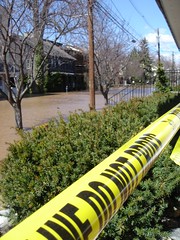 Flooding has been in the news a lot recently, and it can (obviously) be very devastating for a real estate investor. For example, look at what happened to investors whose buildings were flooded in New Orleans due to Katrina: instantly they're no longer collecting rents, their properties require extensive repairs, and their investments are worth significantly less than before the flood. Future investors will certainly need to factor these risks into any future purchases.
Flooding has been in the news a lot recently, and it can (obviously) be very devastating for a real estate investor. For example, look at what happened to investors whose buildings were flooded in New Orleans due to Katrina: instantly they're no longer collecting rents, their properties require extensive repairs, and their investments are worth significantly less than before the flood. Future investors will certainly need to factor these risks into any future purchases.
The above case is pretty easy to analyze because the risks are fairly well known. There are times when the problem isn't so straightforward.
One such case is when flood patterns change, sometimes very unexpectedly. The Delaware River, for example, runs along the border between New Jersey and Pennsylvania. Anybody who is familiar with the Delaware and its river towns are most likely familiar with the notorious Flood of 1955, which was the worst in living memory. Afterwards, there was a long period without much flooding. Seemingly all of the sudden there have been a series of very bad floods the past few years. In fact, if you examine historical flood data, you'll see that half of the "Major Flood Stage" crests on record occurred in 2004-2006 (For these numbers, I am using historical crest data at Riegalsville, PA. Major flood stage is 30ft.).
- 38.85 ft on 1955/08/20
- 35.90 ft on 1903/10/10
- 34.07 ft on 2005/04/3
- 33.62 ft on 2006/06/29
- 32.45 ft on 1936/03/19
- 30.95 ft on 2004/09/19
The first question that comes to mind is, why all of the sudden have there been so many floods. Proposed reasons include (source):
- Poor management: floods could be minimized by regulating flow into and out of reservoirs that release water upstream
- Overdevelopment and construction, both along the main stem of the river and its tributaries.
- Bad luck. Too much rain, too quickly.
A friend of mine lives on the river in what was thought to be a 50-year flood-plain (this means that he has a 1/50 chance, or 2%, of having his house flooded in any given year). The river entered his house in each of the three floods listed above. Each time, he has had to refinish walls, replace appliances, landscape his washed-away driveway and yard, etc. His house was worth upwards of a few million dollars in 2003, and he believes that these floods could have eaten away over 30% of this value.
His flood insurance does help somewhat, however each flood still ends up costing him thousands of dollars, not to mention the hours of work preparing, evacuating, and then restoring. He personally believes that upriver construction is primarily responsible for the problem, and is interested in selling the property if he can get what he believes it is worth. He acknowledges that this will most likely require him to wait for an extended period without floods.
As an investor, how can you prepare for a situation like this? Should you simply avoid buying a place anywhere near rivers or lakes? If not, how do you prepare for the potential financial hit? How about other natural disasters, like earthquakes in California?
Personally, each of the places that I've purchased are in areas where it is highly unlikely that they're going to have problems with a flood, and I am certainly comforted by this. I can appreciate how desirable water-front property is, but I believe that in order to purchase it as an investment you need to have a very large slush fund set aside (making it much less lucrative).
(Note: I took the above picture in Lambertville, NJ in April, 2005. If you would like to see more, check out this guy kayaking in his backyard, a submerged river-front shop, or an image of the Lambertville Station (there are two parking lots under there.)









No comments:
Post a Comment